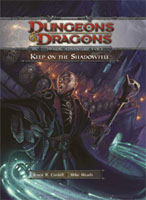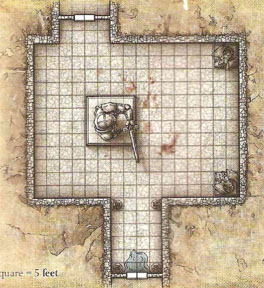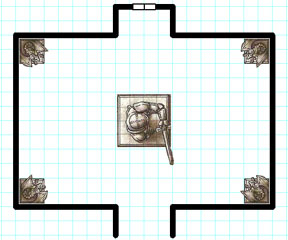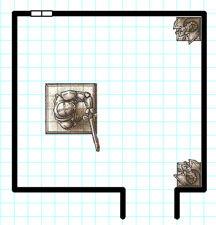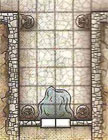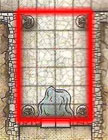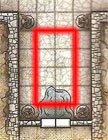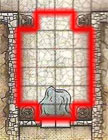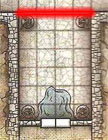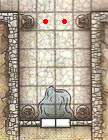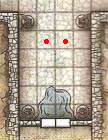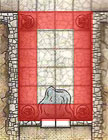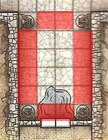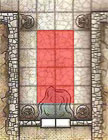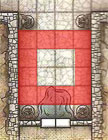|
KEEP ON THE SHADOWFELL ANALYZING THE CHAMBER OF STATUES SPOILER WARNING! The following thoughts contain minor spoilers for Keep on the Shadowfell. If you don't want to be spoiled, don't read it. And if you're in my gaming group then you definitely shouldn't be reading it.
TRAPS IN 4th EDITION One of the features of 4th Edition that has been widely touted in WotC's promotional material have been the new trap design focusing on active traps. Basically, the argument is made that traditional traps either (a) suck up a lot of time because they encourage players to make constant Search checks; (b) are nothing more than random dice rolls that deal out arbitrary damage; and/or (c) focus the spotlight on the player of the rogue while everyone else sits around twiddling their thumbs. The new 4th Edition-style traps will allow everyone in the party to participate in overcoming the trap. This seems like a laudable goal, but the actual examples we were given turned out to be fairly lackluster. They still required skill checks to detect them. They were slightly more interactive than a simple pit trap, but were pretty tame compared to some of the stuff we saw in the Book of Challenges (a 3rd Edition supplement that came out back in 2002), Traps & Treachery (a D20 supplement from Fantasy Flight Games that came out in 2001), or Grimtooth's Traps (an entire line of supplements that date back to 1981). (Which ties into one of the reasons I've been perpetually turned off by the 4th Edition preview material. They seem to be constantly shouting about how they've reinvented the wheel. I like wheels as much as the next guy, but when somebody asks me to get excited about them I tend to get turned off by the fake enthusiasm.) As for the effort to make traps into something that everybody can take part in, that seems to have boiled down to: The rogue makes a lot of skill checks and, if that doesn't work, then everybody else can beat the crap out of it. For example, here's the countermeasures for the Whirling Blades trap (the first example of their "innovative" 4th Edition traps):
Color me unimpressed. I mean, there's nothing wrong with that. But when you claim that one of the fundamental gameplay elements of D&D for the past 30+ years have "rarely had a positive effect on the game", then the examples you give of "fixing" the "problem" probably shouldn't look exactly like the stuff we've been seeing in our D&D supplements for the past 30+ years.
THE CHAMBER OF STATUES
Keep on the Shadowfell has a couple of traps: There's a bog standard pit trap. There are some runes that cause characters to flee in panic. And then there's Area 16: The Chamber of Statues. The Chamber of Statues is a two-part trap, but I'm only going to be talking about the first part. In this section there are three statues, starting with a large titan statue in the middle of the room which acts like a monster. On its initiative it uses its sweeping blow ability:
In other words, the titan statue picks a square in either its own space or immediately adjacent to its space. That square is the center of an 7-square by 7-square area. It then makes an attack against all non-Evil creatures within that area. The titan statue is accompanied by two dragon statues, each of which use a force breath ability:
In other words, if you try to circle around the titan statue's reach the dragon statues will hit you with their force breath and push you back towards the titan statue. It's a simple dynamic, but it has a lot of potential to be fun in play. Unfortunately, there are several design problems here. THE WALK AROUND: One of the ways you can work your way through the trap is to make an Athletics check to jump onto the statue. This allows you to avoid the titan statue's attacks. So you could potentially jump onto the statue, avoid its attacks, jump off the other side and head to safety on the other side of the room (without ever getting close enough to the dragon statues to get targeted by their force breath). The problem is that there's absolutely no reason to do that: You can simply walk right past the entire trap. Why? The titan statue's sweeping blow isn't triggered as a reaction -- its an action taken on the titan statue's initiative. Nor does the titan statue have reach (which would allow it to take opportunity attacks). That means, once the titan statue makes its first attack, everyone is free to walk right past it. LACK OF COOPERATION: As with the sample traps posted on WotC's website, this trap features the ability to either whack on it or disable it. This theoretically opens up a bit more interactivity than the website samples because, in this trap, there are multiple targets that aren't dependent on each other: The thief could be working on the titan statue while the other characters are whacking away on the dragon statues. Only that isn't actually true, because there's no reason to go anywhere near the dragon statues (even if you don't simply walk right past the entire trap): If you stick to the west side of the titan statue you're completely out of their range. LACK OF COOPERATION 2: This trap also introduces the ability for non-Thievery checks to disable traps: The dragon statues (but not the titan statue) can be disabled by either four successful Thievery checks or six successful Arcana checks. Setting aside the fact that disabling the dragon statues is completely irrelevant, there's a deeper design problem here: The Thievery and Arcana checks can't be used in conjunction with each other. Either you disable the trap using Thievery checks or you disable the trap using Arcana checks -- you can't mix-and-match. Based on other traps in the adventure, this seems to be a frequent (but not required) feature of magic-based traps. However, it always requires more Arcana checks than Thievery checks, which means that you'll always see the exact same dynamic in play with traps of this type: The guy with the Thievery skill will try to disable the trap. If he fails, the guy with the Arcana skill will try to disable the trap. This doesn't actually make the trap any more interactive, nor does it actually get more players involved in the process. (At any given time, there's still just one guy making skill checks.) It just means that the entire thing takes more time and becomes a lot more monotonous. WotC claims that one of the problems with traps in 3rd Edition was that the rogue made a Disable Device check while everyone else sat around and watched him. So explain to me how this is "fixed" by giving us a trap in which the rogue makes 6+ skill checks in order to disable the trap while everybody else stands around watching them work? (Why 6+ checks? An Athletics check to jump up on the statue. A Perception check (DC 25) to find the access panel. And then at least four Thievery checks to disable the statue. So it will take a minimum of 6 checks, but given the probable skill modifiers of the pregenerated rogue PC they'll probably be making 9 or 10 checks in total.) JUST BEAT THE CRAP OUT OF IT: But none of what I've described actually matters because none of these statues can move and none of them have relevant ranged attacks. This means that the PCs will stay in the safe area by the northern door and use their ranged attacks to whittle away at the titan statue's hit points.
THE BOTTOM LINE So this entire elaborate trap which, at first glance, appears to be filled with interesting possibilities, will, in fact, be resolved in one of three exceptionally boring ways: (1) One of the PCs will suffer 1 or 2 attacks from the statue and then they'll all walk out of the room. (2) The rogue will make a half dozen or more skill checks and then they'll all walk through the room. (3) The PCs will engage in the most boring combat imaginable: Standing where the opponent can't possibly hurt them, the players will repetitively roll dice until they finally manage to rack up the magic number and can walk through the room unimpeded. I honestly don't understand how such a lackluster encounter got designed. I also don't see how it could have possibly been playtested without such fundamental design errors being exploited by the playtesters. (And if it was playtested and the playtesters exposed its flaws, why weren't they fixed?) | |||||
|
FIXING THE CHAMBER OF STATUES THE LAYOUT We'll start by shifting the layout. I think there are two directions we can go with this. CENTERPIECE: First, we can make the room larger, put the titan statue in the center of the room, and add some additional dragon statues.
With this layout, whenever the PCs try to circle around the dangerous sweeping blow of the titan statue, the dragon statues will push them back towards the center of the room. ILLUSION OF SAFETY: This layout has a greater similarity to the original layout and doesn't increase the number of dragon statues.
With this layout, clever PCs will notice the limited range of the titan statue's attack and conclude that they can safely circle around it to the east. But if the try that, the dragon statues will use their force breath ability to push them back towards the titan statue.
NO CHEAP SHOTS The dragon statues in the original encounter already have a force shot ability that interacts with the second part of this trap (which I'm not dealing with here):
We're going to make an adjustment to this ability in order to stop the PCs from getting to a safe distance and then taking pot-shots at the titan statue.
PROXIMITY SAFETY We'll use the original mechanics from the encounter to allow a character to make an Athletics check to jump onto the titan statue or the dragon statue. But we'll add the following detail: The dragon statues won't use their defensive force shot against any creature in the same space as another statue (the designer of the trap didn't want to risk having the dragon statues damage the other statues). So getting onto a statue makes a character effectively immune against the titan statue's sweeping blow and the force abilities of the dragon statues. However, there's a limited number of such safe zones in the encounter (particularly if you use the Illusion of Safety layout).
COOPERATION By making the dragon statues an active part of the encounter that can't simply be ignored, we've already encouraged a higher level of cooperation: The rogue can only be dealing with one statue at a time, making it necessary for the other characters to deal with the other statues (or at least take actions to avoid them until the rogue can deal with them). However, we'll go one step further and make it possible for more than one character specialty to work on a single statue at the same time. For the titan statue:
For the dragon statues:
Now the rogue and the wizard can work together to rapidly disable the magical statues through the combined use of their skills. If you really wanted spice things up, you could even make it possible for the statues to be bloodied and then add the following:
Now everybody in the party can work to disable a statue together. Instead of having the characters race against each other (will the statue run of hit points, Thievery checks, or Arcana checks first?), all of the characters can work together towards a common goal. This also creates a meaningful strategic choice for the group to make as they try to deal with this encounter: Do we split up and try to deal with the dragon statues separately to clear a path to the exit? Or do we all focus our efforts on disabling the tougher titan statue and reach the exit that way? In this last section, it should be noted, I'm not just talking about adjustments to this particular trap -- I'm talking about house rules which, based on what I've seen of 4th Edition to date, would appear to fundamentally change some of the basic ways in which the game works. But the reward appears to be gameplay which is both more interactive and offers richer strategic and tactical choices. | |||||
|
ROTTEN CHERUBS When I first started remixing the Chamber of Statues, I didn't think I'd be discussing the second part of the encounter. Why? Because there was nothing seriously wrong with that section of the encounter. ... or so I thought. I've been cross-posting these mini-essays on Keep of the Shadowfell to WotC's forums, and the discussion there revealed there was actually a rather serious problem with that section of the encounter.
In this section of the encounter, there are four cherub statues. When triggered, the cherubs create an arcane cage to trap a victim. The cherubs then pour water into the arcane cage, which triggers a whirlpool effect that smashes the victim into the cherub statues and cause them to take damage. The key element to this encounter is the arcane cage that the statues create:
The key problem here is the phrase "create a wall of arcane magic to enclose the area between the four statues". When I first read that phrase, I interpreted it as meaning that the arcane cage enclosed the entire 4x6 hallway, including the cherub statues. But then I realized that the other half of the encounter talks about the dragon statues reacting to characters outside the arcane cage attacking the cherub statues, so I concluded that the arcane cage must only enclose the 2x4 area between the cherubs. I thought the phrasing was a little unclear, but no big deal. Except it turned out I wasn't the only one who had interpreted that phrase differently. In no time at all, in fact, the conversation included four mutually incompatible interpretations of what the arcane cage did and they were all legitimate interpretations of the phrase "create a wall of arcane magic to enclose the area between the four statues":
To this muddle we can also add some confusion from the phrase "when a creature walks past the northern two statues". There seem to be two meaningful possibilities for this:
(Of course, if you go with the second possibility for the arcane cage, the answer to this question is pretty obvious -- it'll be the one that actually traps the triggering character inside the cage.)
PROBLEMS, PROBLEMS, PROBLEMS In trying to work out how this encounter is supposed to work, we can try to narrow the possibilities down by taking two facts into consideration: (1) Barrier effects "run along the edge of a specified number of squares". Since each statue is entirely within one square, the statues either have to be inside the barrier or they have to be outside the barrier -- they can't be both. (2) The dragon statues are supposed to be able to use their force shot ability against characters outside the barrier making attacks against the statues. Therefore, the statues have to be outside the barrier. (And even if this wasn't true, you wouldn't want a scenario where the only character who can lower the cage is the character trapped inside the cage: If they get killed by the whirlpool effect, not only are the irretrievable, but the location of the cage effectively prevents the rest of the group from reaching the end of the adventure.) Thus we can conclude that it must be one of these two scenarios:
... except these doesn't actually work. First, because the cherubs have to be inside the cage (they're pouring water into the cage and the trapped character is slammed against them for damage). Second, because under this interpretation the guy inside the cage is effectively taken out of the game: There's nothing they can do to escape. All they can do is hang tight, soak up the damage each round, and hope somebody gets them out. (This second problem isn't necessarily unworkable, it's just a questionable design choice.) In short, the encounter doesn't work. The cherubs have to both inside and outside the cage and, according to the rules of the game, that can't happen. As I see it, there are two options: (1) Use the 2x4 option and then break the rules, basically creating an ad hoc ruling that the character inside the force cage can attack and destroy the cherubs even though they shouldn't be able to. (2) Redesign the encounter so that each cherub statue takes up 2 squares (and, thus, you can have them half-in and half-out of the arcane cage without breaking the rules).
FUEL ON THE FIRE After writing up this whole analysis, I was looking through my friend's copy of the Player's Handbook and discovered something that only serves to deepen the confusion over what the arcane cage is supposed to be doing. In the Quick Start Rules that came with Keep on the Shadowfell, there were three areas of effect defined: Barriers, Blasts, and Bursts. In the PHB, on the other hand, barriers no longer exist. They've been replaced by walls. Here are the rules from Keep on the Shadowfell:
And here are the rules from the PHB:
I have two reactions to this: (1) Why wasn't this fixed in the Quick Start Rules? Yet another example of sloppy editing. (2) The encounter still doesn't work.
It can't be option #1 because the arcane cage is a solid wall (otherwise you could walk through it and the trap would be pointless), and therefore it can't be formed in the squares occupied by the cherub statues. It can't be option #2 because walls must fill contiguous squares and each square must share a side -- not just a corner -- with at least one other square of the wall. It can't be option #3, obviously, because then there's no interior of the cage for someone to be trapped in. It can't be option #4 because the trigger for the arcane cage would either result in no one being trapped inside or would make it impossible for the wall to form (since the triggering character would be occupying one of the squares the wall has to fill). There are two possible ways of handling this: (1) You can use option #4, change the trigger for the trap (so that it goes off when a character enters one of the squares inside the arcane cage), and then ignore the rules so that the cherubs are somehow inside the cage (despite the fact that they're nowhere near the inside of the cage). (2) You can use option #2 and rewrite the effect so that it creates multiple walls. Unfortunately, it's not clear whether or not a character inside the arcane cage can attack the cherubs. (There's a clear rule that says you can't move across a diagonal if one of the squares bordering the diagonal has a solid barrier in it, but I can't find any rule that tells you whether or not you can attack through a diagonal where two solid barriers meet.)
THIS IS RIDICULOUS Needless to say, I consider this to be ridiculous. I consider the complete inability for this encounter to work as written just further evidence that Keep on the Shadowfell was never playtested. Such a shoddily designed encounter would, frankly, be inexcusable in any professional product. But it completely baffles me that WotC evidently spent so little effort and care on the product they chose to serve as the flagship for 4th Edition. | | Link |
